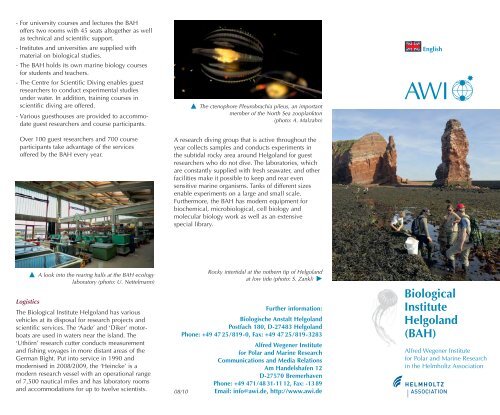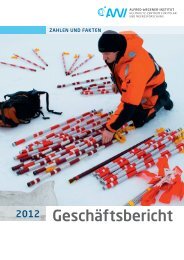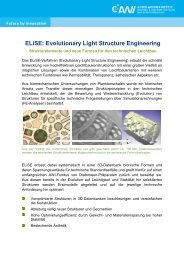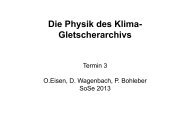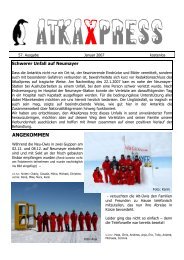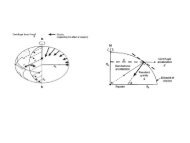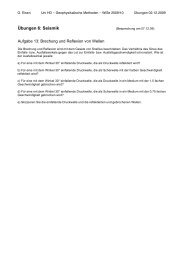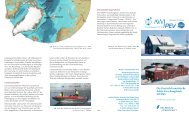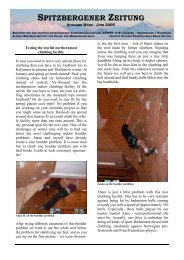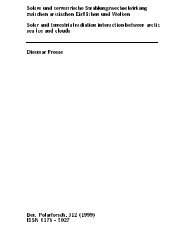Biological Institute Helgoland (BAH) - AWI
Biological Institute Helgoland (BAH) - AWI
Biological Institute Helgoland (BAH) - AWI
Create successful ePaper yourself
Turn your PDF publications into a flip-book with our unique Google optimized e-Paper software.
- For university courses and lectures the <strong>BAH</strong><br />
offers two rooms with 45 seats altogether as well<br />
as technical and scientific support.<br />
- <strong>Institute</strong>s and universities are supplied with<br />
material on biological studies.<br />
- The <strong>BAH</strong> holds its own marine biology courses<br />
for students and teachers.<br />
- The Centre for Scientific Diving enables guest<br />
researchers to conduct experimental studies<br />
under water. In addition, training courses in<br />
scientific diving are offered.<br />
- Various guesthouses are provided to accommodate<br />
guest researchers and course participants.<br />
Over 100 guest researchers and 700 course<br />
participants take advantage of the services<br />
offered by the <strong>BAH</strong> every year.<br />
� A look into the rearing halls at the <strong>BAH</strong> ecology<br />
laboratory (photo: U. Nettelmann)<br />
Logistics<br />
The <strong>Biological</strong> <strong>Institute</strong> <strong>Helgoland</strong> has various<br />
vehicles at its disposal for research projects and<br />
scientific services. The ‘Aade’ and ‘Diker’ motorboats<br />
are used in waters near the island. The<br />
‘Uthörn’ research cutter conducts measurement<br />
and fishing voyages in more distant areas of the<br />
German Bight. Put into service in 1990 and<br />
modernised in 2008/2009, the ‘Heincke’ is a<br />
modern research vessel with an operational range<br />
of 7,500 nautical miles and has laboratory rooms<br />
and accommodations for up to twelve scientists.<br />
� The ctenophore Pleurobrachia pileus, an important<br />
member of the North Sea zooplankton<br />
(photo: A. Malzahn)<br />
A research diving group that is active throughout the<br />
year collects samples and conducts experiments in<br />
the subtidal rocky area around <strong>Helgoland</strong> for guest<br />
researchers who do not dive. The laboratories, which<br />
are constantly supplied with fresh seawater, and other<br />
facilities make it possible to keep and rear even<br />
sensitive marine organisms. Tanks of different sizes<br />
enable experiments on a large and small scale.<br />
Furthermore, the <strong>BAH</strong> has modern equipment for<br />
biochemical, microbiological, cell biology and<br />
molecular biology work as well as an extensive<br />
special library.<br />
Rocky intertidal at the nothern tip of <strong>Helgoland</strong><br />
at low tide (photo: S. Zankl) �<br />
Further information:<br />
Biologische Anstalt <strong>Helgoland</strong><br />
Postfach 180, D-27483 <strong>Helgoland</strong><br />
Phone: +49 4725/819-0, Fax: +49 4725/819-3283<br />
Alfred Wegener <strong>Institute</strong><br />
for Polar and Marine Research<br />
Communications and Media Relations<br />
Am Handelshafen 12<br />
D-27570 Bremerhaven<br />
Phone: +49 471/48 31-11 12, Fax: -13 89<br />
08/10 Email: info@awi.de, http://www.awi.de<br />
English<br />
<strong>Biological</strong><br />
<strong>Institute</strong><br />
<strong>Helgoland</strong><br />
(<strong>BAH</strong>)<br />
Alfred Wegener <strong>Institute</strong><br />
for Polar and Marine Research<br />
in the Helmholtz Association
<strong>Biological</strong> <strong>Institute</strong> <strong>Helgoland</strong> (<strong>BAH</strong>)<br />
Alfred Wegener <strong>Institute</strong> for<br />
Polar and Marine Research<br />
The North Sea island of <strong>Helgoland</strong> is located sixty<br />
kilometres off the mainland in the German Bight. A<br />
subtidal rocky landscape measuring over 35 square<br />
kilometres and the rocky intertidal around <strong>Helgoland</strong><br />
are home to the largest variety of marine fauna<br />
and flora species on the German coast. <strong>Helgoland</strong><br />
has attracted natural scientists for over 150 years. In<br />
1835 Christian Gottfried Ehrenberg identified the<br />
small unicellular Noctiluca scintillans as the cause<br />
of marine phosphorescence and ten years later<br />
Johannes Müller established plankton research here.<br />
The ‘Royal <strong>Biological</strong> <strong>Institute</strong>’ was set up on <strong>Helgoland</strong><br />
in 1892 and rapidly developed into an internationally<br />
recognised site for marine biology research.<br />
Destroyed during World War II, the <strong>Biological</strong><br />
<strong>Institute</strong> <strong>Helgoland</strong> (<strong>BAH</strong>) returned to the island in<br />
1959. Since 1998 the <strong>BAH</strong> has been part of the<br />
Alfred Wegener <strong>Institute</strong> for Polar and Marine<br />
Research in Bremerhaven.<br />
� Fresh catch with a beam trawl on board the ‘Uthörn’<br />
research cutter (photo: H.-D. Franke)<br />
Research<br />
Thanks to its location on an island in the middle of<br />
the sea, the <strong>BAH</strong> provides ideal conditions for marine<br />
biology research both in the field and in its<br />
� Research divers during an operation at the subtidal<br />
rocks of <strong>Helgoland</strong> (photo: <strong>BAH</strong> archive)<br />
expansive laboratory and rearing facilities. The focal<br />
points of research at the <strong>Biological</strong> <strong>Institute</strong> are:<br />
- Lifecycles, ecology and behaviour of marine<br />
organisms<br />
- Structure of the food web in shelf seas<br />
- Climate impact research and long-term changes in<br />
the ecosystem<br />
- Microbiological coastal research<br />
<strong>BAH</strong>’s far-reaching field of research, including studies<br />
on diverse organisms (from unicellular organisms to<br />
lobster and fish), is gaining increasing importance in<br />
view of climate change and anthropogenic pollution<br />
of our oceans.<br />
Regular measurements and observations over long<br />
periods of time have been carried out by the <strong>Biological</strong><br />
<strong>Institute</strong> right from the beginning. The valuable<br />
long-term <strong>Helgoland</strong> time series (<strong>Helgoland</strong> Roads<br />
data) point out the growing influence of humanity on<br />
the living conditions and biotic communities of the<br />
North Sea. Documenting changes in the structure and<br />
function of the ecosystem and determining their causes<br />
(climate change, introduction of species that are<br />
new to the area and the like) as well as presumed<br />
consequences for fishing, shipping and tourism are<br />
the main objectives of research on <strong>Helgoland</strong>.<br />
By studying the environmental<br />
demands of species and biotic<br />
communities as well as the significance<br />
of biodiversity for the<br />
function of such communities<br />
and analysing ecological relationships<br />
between species (food<br />
web, competition for food and<br />
space, symbioses), scientists gain<br />
a constantly growing understanding<br />
of the structure and dynamics<br />
of the complex ecosystem<br />
in the German Bight and other<br />
shelf sea areas.<br />
The researchers on <strong>Helgoland</strong><br />
work closely together with other<br />
national and international colleagues<br />
in joint programmes.<br />
Scientific services<br />
In addition to its research work, the <strong>BAH</strong> performs<br />
a number of services:<br />
- A public aquarium displays marine organisms in<br />
an environment that is close to nature.<br />
- Political and economic decision-makers are<br />
advised on current aspects of marine ecology.<br />
- The journal ‘<strong>Helgoland</strong> Marine Research’ is<br />
published jointly with Springer-Verlag.<br />
- Guest researchers have workstations at their<br />
disposal for their own research projects and<br />
receive technical and scientific support.<br />
� The amphipod Caprella mutica, a species now widespread<br />
in the North Sea, which originally comes from<br />
Pacific waters (photo: K. Boos)


